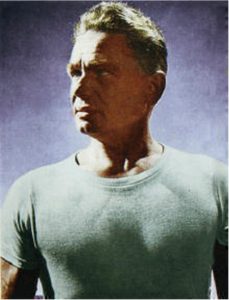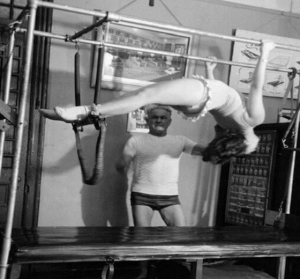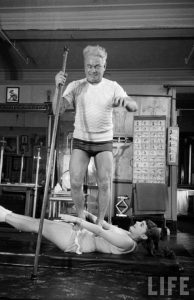This rare interview with Joseph Pilates was written by Marie Beynon Ray for The National Weekly’s August edition 1934. Discover rare insights about the man who started the movement revolution we embrace today, and how much (or little) has changed when it comes to self perception, body image and the science of moving.
Have You Ever Seen A Person Grow Young Again?
I met an acquaintance the other day whom I hadn’t seen for two years; almost passed her by because she’d grown – not so much older, but so much younger.
Did she have a facelift? Some funny gland treatment? Perhaps she fell in love? It was none of these things. It wasn’t her face that was younger, but it isn’t the face that grows old first? Then it’s the body, the poor old body which slumps and sags and develops the middle‐aged spread, or the office slouch or the housekeepers’ droop. Whatever you want to call it, I remembered this friend as being the office type; stooping shoulders, head forward, scrawny, strangely hollowed. But not anymore.
“It sounds just too awful,” she admitted, “and at first it was awful,” but what I’ve been doing, since you’re so flattering about my appearance, is going to a gym. I happened to glance in a full length mirror when I was naked and I was revolted. I saw what fifteen years of sitting at a desk had done to me, and I shuddered. I’d always gone for sports in a moderate way but while the exercise made me feel fine, it certainly didn’t stand the test of time. There was that settled, solid, inelastic look about me that is definitely middle-age. That you’ll never climb a fence or leap a brook again look. Besides, all the little lumps and bumps and hollows come with being forty, don’t they? I resolved to take steps, and behold me, the complete dryad.”
Only the day before, I had spoken with a doctor on this same subject, Dr. Kristian Hansson, Director of Physical Therapy at the Hospital for the Ruptured and Crippled and several other hospitals in New York. He spoke of the deformities that come with advancing age; how we become narrow at the chest and wide at the abdomen. If we can manage to prevent this, and we can, our bodies retain their youthful lines into old age. Sports won’t do this but remedial exercises will.

I glanced now at the man I had come to see, Joseph Pilates; living proof of the truth of these statements. Standing there in his trunks, he appeared to be in his twenties. He assured me he was fifty four. I couldn’t believe it.
Joseph Pilates originated a system of exercise used by the Hamburg police, he has been painted and sculptured by innumerable famous artists, and he can do more with one hand than many a champion can do with his whole body. Best of all, he is a humanitarian. He wants the whole human race to be beautiful and healthy and, barring acts of God, he can tell them how.
It Can’t Be Done By Games

‘Corrective exercise’ is a nasty pill to most people, but it’s the only way to build a beautiful, strong, youthful and 100% healthy body. It would be swell if it could be done by games, but it can’t.’
The doctors back this up. Practically all sports are one-sided. The person that swings a tennis racket all day is forging a lopsided body as surely as the person that wields a pick. The athlete, as much as the man or woman who sits all day at a desk; needs remedial exercises to counterbalance the effects of his or her daily physical habits.”
Nature’s Corset
Women particularly accuse their figures of all sorts of crimes. One complains of sway-back, incurable, she says, since she’s had it from childhood. Another bemoans her prominent stomach; a third is having a masseuse in twice weekly to rub away a dowager’s hump; a fourth makes faces over olive oil, taken to fill out the hollows in her neck; a fifth suffers agonies because of a flat bosom, and others do all sorts of strange and futile things to correct wing shoulders, hollow chests, double chins, bowlegs, or do nothing, just complain, because they think nothing can be done.

How wrong she was, how wrong she still is, for that matter. Twenty, thirty directions are given to obtain correct posture, and only one (we have the authority of Pilates for this) is necessary; the good, old army order, it wouldn’t get printed, so I’ll translate “Pull the abdomen in.”
Here is a portrait of the average man or woman, you can look in the mirror and decide whether you’re a mild or an exaggerated case. Head forward, two or three inches out of alignment with the spine; shoulders rounded, chest hollowed, spine curving noticeably forward at the waistline, abdomen protruding. So universal is a noticeable forward curve of the spine that doctors, and sculptors, who have an even surer eye in these matters, have accepted it as the natural and normal thing. It isn’t.
How do we know? The most beautiful bodies don’t have it. Normal children don’t have it. And those who have a normally straight spine have far better control of their bodies than those who don’t. Practically every fault of the figure comes down in the last analysis to this matter of a normally straight spine. There are slight natural curves, not noticeable in the naked body but which an X‐ray picture reveals. The straighter the spine the better the figure.
To straighten the spine what we chiefly have to do is to “pull in the abdomen.”
Sounds simple, doesn’t it? But of course it has to be done in a special way. The hips must be thrown forward, without bending or locking the knees, and tensed; the lower abdomen held it, thus forcing the chest high and the head up, without lifting the shoulders, and that position must be held as long as possible. And because it’s such a little thing to do, you have to do it constantly. “Pull your abdomen in,” you must say to yourself dozens, hundreds of times a day, till pulling it in becomes a habit and sinks down into the subconscious where your breathing is taken care of. But you can encourage yourself with the assurance that every single time you do it, you’re a little farther ahead.
The Best Remedial Exercises for a Young Spine
You can’t get away from it, a few remedial exercises must be done daily, that is if you care two pins about having a twenty-year-old figure at the age of fifty. Of course, they must be exactly the right exercises; so in Part 2 of this interview, you’ll find the exercises hand-picked by Joe Pilates to achieve a youthful spine.


